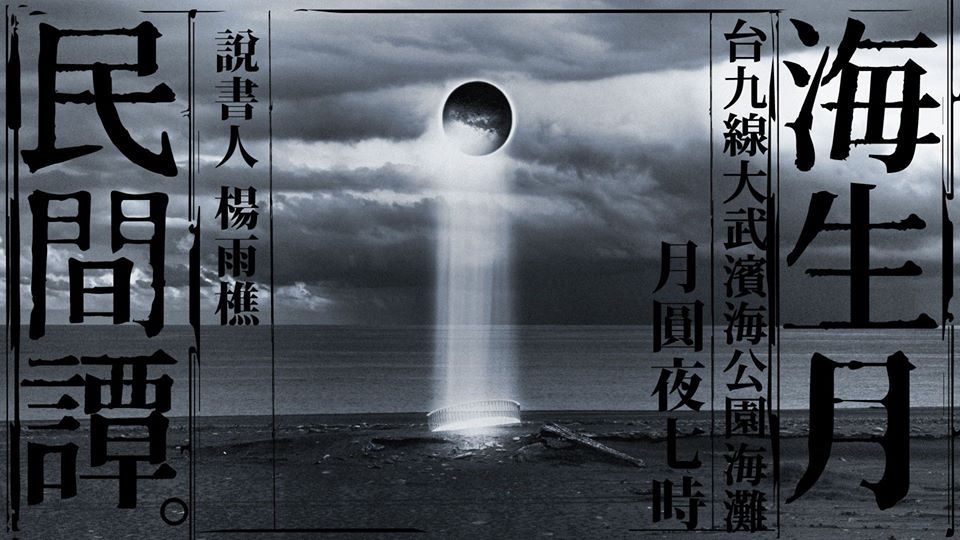海生月民間譚
Folk Tales of the Sea and the Moon
Folk Tales of the Sea and the Moon
7/28, 2018
月圓夜七時
台九線大武濱海公園海灘
![]()
我們與海相處,就像與我們親近的人相處。不過我們經常會有這樣的經驗:就算是無時不刻相處的人,也會在某一天突然展現出我們從來不知道的面貌。海更是如此,我們未能窺見的海之面貌如此繁多。人每一次出航,或行走於海濱,就採集到一次海的面貌。但從古到今,人採集到的數萬個面貌的累積,也還未能窮盡海的所有模樣。
「那是什麼?」「我要怎麼稱呼那個東西?」我們這樣詢問海,正如古代的人們也這樣詢問海。在詢問的過程中,有些故事發生了,這些故事裡面,人們的遭遇,使人們自己在海的千萬種面貌間穿梭。而藉由這些古代口耳相傳下來的故事,我們嘗試把眼光重新放在我們熟悉的東西上:海水、海砂以及其他,讓我們觸碰海水、海砂,在它們的千萬種面貌間穿梭。
Human beings have lived with the sea like living with a close friend. However, this is an experience we would often have: even those we have spent so much time with might someday suddenly show a side that we have never seen before. The sea is even more so. There are so many faces of the sea that we have never seen. Every time one sets out on a voyage or takes a walk on the seashore, one detects a different look of the sea. Since the ancient time, human begins have collected innumerous faces of the sea but have yet seen them all.
“What is that?” “What is that called?” These are questions we often ask the sea, just like what people would ask in the ancient time. During the process of inquiry, some stories usually happen, and people encounter countless countenances of the sea in these stories. Throughout history, these stories are passed from one generation to another through oral tradition. In this event, we try to move our focus back onto the things we are familiar with: the sea water, the sand and other things. Let us touch the sea, step onto the sand and explore the infinite oceanic countenances.
說書人|楊雨樵
喜歡散步,喜歡樹的屍骨。現專職為口頭傳統民間譚的言說藝術表演者。致力於彙整各地的古代文字、神話譜系與民間譚,並自 2014 年開始於全台各地開設「世界民間譚講座」。曾受聲樂訓練,以獨唱家身份自 2007 開始與各大學合唱團及其他專業樂團合作演出,2015年於台中「溪流」空間表演《我好樂—-巴哈、普賽爾歌曲與西歐民間故事》。並與藝綻室內樂團合作,於台灣各地各級學校進行音樂教育的推廣與引薦。2017年以民間譚言說藝術表演者身份,與藝綻室內樂團合作演出《純粹。聽說》。創作部分,著有甲骨文異譚集:《藝》——字中事(2014),《易》——字中事(2016),與畫家陳澈合作出版版畫詩集《Counterpoint Archive》(2017),並創辦表面雜誌《COVER》(2017-)。
月圓夜七時
台九線大武濱海公園海灘

我們與海相處,就像與我們親近的人相處。不過我們經常會有這樣的經驗:就算是無時不刻相處的人,也會在某一天突然展現出我們從來不知道的面貌。海更是如此,我們未能窺見的海之面貌如此繁多。人每一次出航,或行走於海濱,就採集到一次海的面貌。但從古到今,人採集到的數萬個面貌的累積,也還未能窮盡海的所有模樣。
「那是什麼?」「我要怎麼稱呼那個東西?」我們這樣詢問海,正如古代的人們也這樣詢問海。在詢問的過程中,有些故事發生了,這些故事裡面,人們的遭遇,使人們自己在海的千萬種面貌間穿梭。而藉由這些古代口耳相傳下來的故事,我們嘗試把眼光重新放在我們熟悉的東西上:海水、海砂以及其他,讓我們觸碰海水、海砂,在它們的千萬種面貌間穿梭。
Human beings have lived with the sea like living with a close friend. However, this is an experience we would often have: even those we have spent so much time with might someday suddenly show a side that we have never seen before. The sea is even more so. There are so many faces of the sea that we have never seen. Every time one sets out on a voyage or takes a walk on the seashore, one detects a different look of the sea. Since the ancient time, human begins have collected innumerous faces of the sea but have yet seen them all.
“What is that?” “What is that called?” These are questions we often ask the sea, just like what people would ask in the ancient time. During the process of inquiry, some stories usually happen, and people encounter countless countenances of the sea in these stories. Throughout history, these stories are passed from one generation to another through oral tradition. In this event, we try to move our focus back onto the things we are familiar with: the sea water, the sand and other things. Let us touch the sea, step onto the sand and explore the infinite oceanic countenances.
說書人|楊雨樵
喜歡散步,喜歡樹的屍骨。現專職為口頭傳統民間譚的言說藝術表演者。致力於彙整各地的古代文字、神話譜系與民間譚,並自 2014 年開始於全台各地開設「世界民間譚講座」。曾受聲樂訓練,以獨唱家身份自 2007 開始與各大學合唱團及其他專業樂團合作演出,2015年於台中「溪流」空間表演《我好樂—-巴哈、普賽爾歌曲與西歐民間故事》。並與藝綻室內樂團合作,於台灣各地各級學校進行音樂教育的推廣與引薦。2017年以民間譚言說藝術表演者身份,與藝綻室內樂團合作演出《純粹。聽說》。創作部分,著有甲骨文異譚集:《藝》——字中事(2014),《易》——字中事(2016),與畫家陳澈合作出版版畫詩集《Counterpoint Archive》(2017),並創辦表面雜誌《COVER》(2017-)。